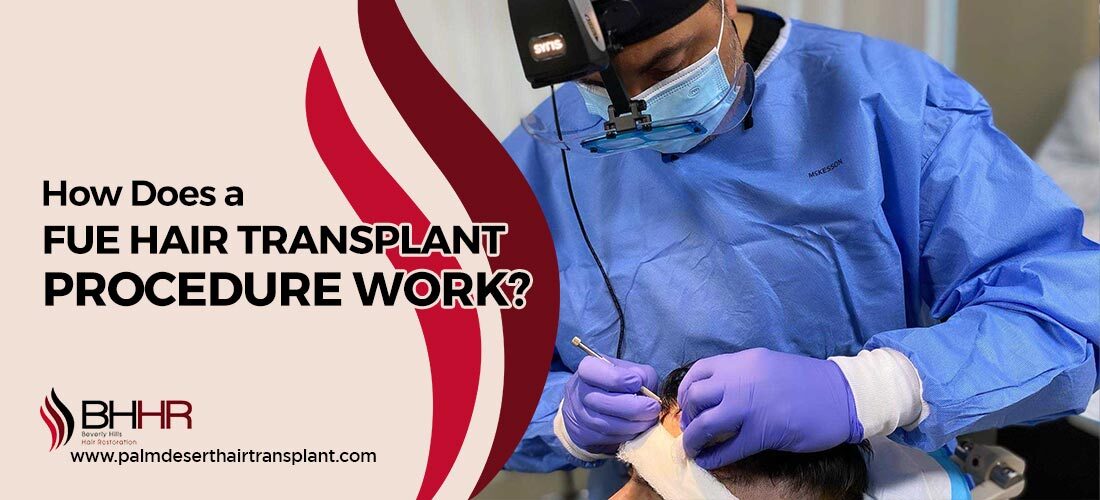How Does a FUE Hair Transplant Procedure Work
Home / FUE Hair Transplant / How Does a FUE Hair Transplant Procedure Work
Updated On : March 18, 2024 | Category : FUE Hair Transplant | Author: Beverly Hills Hair Restoration Team

Hair loss, a widespread concern, can profoundly affect people's self-assurance and general well-being. The FUE hair transplant procedure stands out among various options for its effectiveness and minimal invasiveness. FUE, or Follicular Unit Extraction, represents a state-of-the-art approach promising abundant hair growth without the scarring typically associated with conventional methods. The Beverly Hills Hair Restoration Clinic provides insight into the FUE hair transplant technique, offering hope to individuals with hair loss.
Understanding FUE Hair Transplantation
Follicular Unit Extraction (FUE) is renowned for its minimally invasive approach to hair transplant procedures. It is where individual hair follicles are carefully extracted from a donor area and delicately implanted into the recipient site. Unlike traditional methods like Follicular Unit Transplantation (FUT), FUE does not involve the extraction of a strip of scalp tissue, resulting in less scarring and a quicker recovery time. Eligibility for the FUE procedure depends on factors such as your hair type, scalp laxity, and the extent of hair loss.
Preparing for the FUE Procedure
- Initial consultation: Before undergoing the FUE hair transplant procedure in Palm Desert, individuals typically schedule an initial consultation with Dr. John Kahen, a qualified hair restoration surgeon at Beverly Hills Hair Restoration Clinic.
- Medical history review: Dr. Kahen reviews the patient's medical history, including any underlying health conditions, medications, allergies, and previous hair loss treatments. This information helps assess potential risks and ensure suitability for the FUE procedure.
- Scalp Evaluation: This involves a comprehensive inspection to determine the condition and density of hair follicles within the donor region, typically located on the back or sides of the scalp. The donor area should have sufficient healthy hair follicles for extraction.
- Treatment plan discussion: Based on the assessment, we discuss the treatment options, expected outcomes, and limitations with the patient. A customized treatment plan is formulated, including the number of grafts needed.
- Pre-procedure instructions: Patients are provided with pre-procedure instructions. Which may include guidelines on medications to avoid, lifestyle modifications, and preparation steps to optimize the fue hair transplant success and minimize complications.
FUE Hair Transplantation Procedure Detailed Guide
Anesthesia and Donor Area Preparation
After preparing for the fue procedure, the patient is administered local anesthesia to numb the donor area, typically the scalp's back or sides. This ensures the patient's comfort during the FUE hair transplant procedure. Once the anesthesia takes effect, the donor area is prepared by shaving the hair to a short length, allowing more accessible access to the hair follicles.
Extraction of Follicular Units
With the donor area prepared, the fue hair extraction process begins. Each follicular unit containing one to four hairs is carefully extracted from the scalp using a specialized tool such as a micro-punch or micrografting device. The extraction tool's size and shape can differ based on the patient's requirements. The hair extraction process meticulously surrounds hair follicles and tissue, preserving the donor area's integrity.
Creation of Recipient Sites
Simultaneously with the hair extraction process, recipient sites are created in the recipient area of the scalp, where the extracted follicular units will be implanted. Dr. John Kahen uses a fine needle or blade to make tiny incisions in the balding or thinning areas of the scalp, following a predetermined pattern to achieve natural-looking results. The recipient sites' size, depth, and angle are carefully controlled to accommodate the transplanted follicular units and promote optimal hair growth.
Implantation of Follicular Units
Once the recipient sites are prepared, the extracted follicular units are meticulously implanted into the recipient area. This procedure needs careful handling and expertise to guarantee that the relocated hair follicles are positioned accurately, with depth and density, for a natural appearance. Dr. Kahen may use manual implantation or automated devices to implant the follicular units evenly across the scalp. Throughout the implantation process, Dr. Kahen continuously monitors the placement of the follicular units to ensure consistent and aesthetically pleasing results.
Recovery and Aftercare
After undergoing a FUE hair transplant, patients receive immediate post-operative care guidelines to facilitate healing and reduce discomfort. This may include guidelines on how to clean the scalp, avoid strenuous activities, and manage any potential side effects such as swelling or itching. While the initial recovery typically lasts a few days to a week, it may take a few months for the transplanted hair to grow and blend in with the existing hair thoroughly. Managing expectations during this growth phase is crucial, as hair growth varies from person to person.
Encouragement for Those Considering FUE Hair Transplantation
Beverly Hills Hair Restoration Clinic in Palm Desert offers FUE hair transplant procedures, a safe and effective solution for individuals experiencing hair loss. It's crucial to grasp the fundamental principles and eligibility criteria to make wise choices about restoring your hair. As advancements in hair restoration techniques continue to evolve, the future outlook for FUE and other procedures remains promising. Our hair transplant clinic supports those considering fue hair transplantation to regain confidence and a fuller head of hair. Schedule a consultation today at our hair transplant clinic if you are considering fue hair transplantation and regaining confidence with a fuller head of hair.
For any questions regarding the FUE hair transplant procedure, contact us at 760.501.0080 or for a hair transplant consultation.
